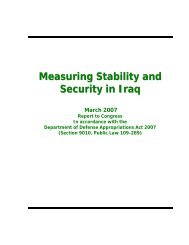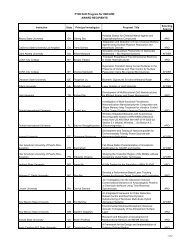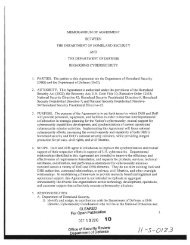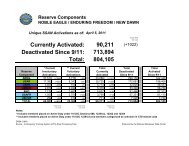Report - United States Department of Defense
Report - United States Department of Defense
Report - United States Department of Defense
Create successful ePaper yourself
Turn your PDF publications into a flip-book with our unique Google optimized e-Paper software.
UNCLASSIFIED<br />
Recent developments in the ICT sector hold promise for continued economic growth. Since the<br />
introduction <strong>of</strong> 3G mobile broadband service in June 2012, 3G service is now provided by three<br />
mobile companies, available throughout 11 provinces and covering 13 provincial capitals (as <strong>of</strong><br />
early February 2013), according to the Ministry <strong>of</strong> Communications and Information<br />
Technology. More than 200,000 Afghans have adopted 3G so far, with that number growing<br />
every day.<br />
On November 18, 2012, the Afghanistan Telecommunication Regulatory Authority issued three<br />
broadband wireless access licenses, which will allow Afghan Internet Service Providers (ISPs) to<br />
provide high-speed last-mile connectivity to Afghan enterprises and institutions, thus improving<br />
access to broadband Internet service. Afghan Telecom Corp. decreased the price <strong>of</strong> terrestrial,<br />
fiber-based Internet bandwidth from $300 per megabyte (MB) per month to $97/MB/month in<br />
January 2013; this price reduction will continue to stimulate Internet demand and usage. These<br />
developments are significant because, according to the World Bank, increased broadband<br />
Internet penetration in developing countries like Afghanistan is estimated to correlate to an<br />
increased GDP.<br />
Fiber infrastructure. Approximately 2,400 km <strong>of</strong> fiber, or nearly 73 percent, <strong>of</strong> the originally<br />
planned 3,300 km Optic Fiber Cable (OFC) is complete and operational to date. The strategically<br />
significant southeast sector – Kabul to Kandahar – was completed in January 2013, but is not yet<br />
operational due to security issues that correctly preclude Afghan Telecom Corporation (AfTel),<br />
the state-owned wire line and wireless telecommunications operator, from activating and<br />
maintaining this segment. The completion <strong>of</strong> the southeast segment will improve governance,<br />
development, and security in key coalition areas <strong>of</strong> operation, and provide an alternate and<br />
redundant path <strong>of</strong> connectivity into Pakistan and undersea cables to the south. Additionally,<br />
completion <strong>of</strong> the southeast segment will allow for additional fiber installation resources to be<br />
shifted to the southwest, thereby accelerating progress in that region. There are approximately<br />
900 kilometers <strong>of</strong> fiber remaining to be installed in the southwest region.<br />
Cellular infrastructure. The Ministry <strong>of</strong> Communications and Information Technology recently<br />
awarded a 3G license to the firm Roshan to join the private firms Etisalat and MTN in <strong>of</strong>fering<br />
service. The ministry's goal is for 50 percent <strong>of</strong> Afghans to use 3G networks within two years.<br />
A report by the telecom research company BuddeComm estimates that in 2012, some 20 million<br />
Afghans subscribed to a mobile phone plan, an increase <strong>of</strong> 14 percent over 2011. Ten years ago,<br />
only 20,500 Afghans were subscribers.<br />
As <strong>of</strong> June 2012, 4,670 base transceiver stations (BTSs) were in place throughout Afghanistan,<br />
providing cellular coverage to 88 percent <strong>of</strong> the population. In November 2012, AfTel<br />
announced it was embarking on a plan to roll out a new 2G and 3G GSM technology cellular<br />
network throughout the country. In support <strong>of</strong> ISAF's and GIRoA’s stability and governance<br />
objectives, Afghan Telecom is primarily focusing on bringing communications to the<br />
underserved rural districts and providing continuous 24/7 cellular service in some <strong>of</strong> the most<br />
dangerous districts <strong>of</strong> Afghanistan. Based on an ambitious restructuring and operational<br />
effectiveness improvement program, the company is targeting June 2013 for the commercial<br />
network launch. Afghan Telecom plans to establish service in approximately 250-300 additional<br />
locations.<br />
161

















